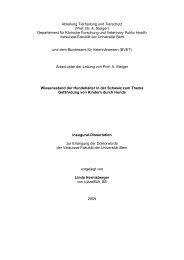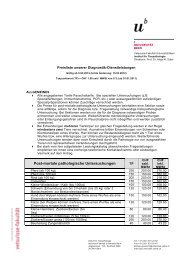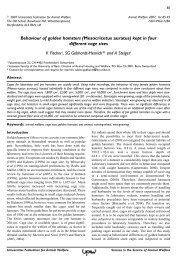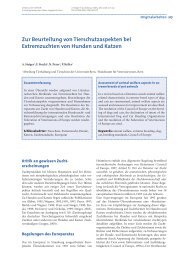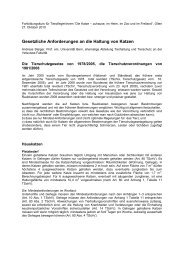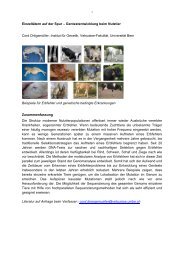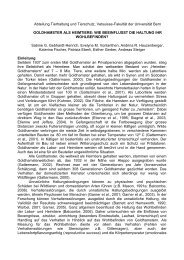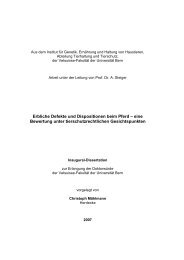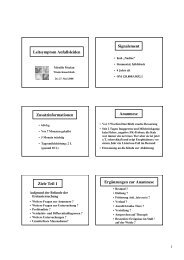Behaviour of golden hamsters (Mesocricetus auratus) - Vetsuisse ...
Behaviour of golden hamsters (Mesocricetus auratus) - Vetsuisse ...
Behaviour of golden hamsters (Mesocricetus auratus) - Vetsuisse ...
Create successful ePaper yourself
Turn your PDF publications into a flip-book with our unique Google optimized e-Paper software.
IntroductionHamsters are common laboratory animals in biomedical research as well as popularpet animals. Nevertheless, little work has been done with the specific intent <strong>of</strong>improving their housing conditions, especially for pet animals. Exceptions are thework by Kuhnen (1999a), Bantin and Sanders (1989) on cage size, Mrosovsky et al.(1998) on running wheel choice by Syrian <strong>hamsters</strong>, and Reebs and Maillet (2003)on environmental enrichment. Reebs and Maillet (2003) showed that there werefewer daily revolutions, shorter wheel running activity phases, and delayed runningactivity onsets in <strong>hamsters</strong> housed in multiple-cage systems enriched with a runningwheel and commercial wooden toys compared with <strong>hamsters</strong> housed in single cageswith a running wheel, without other enrichments. Mrosovsky et al. (1998) found that<strong>golden</strong> <strong>hamsters</strong> ran more in wheels with the floor covered by a plastic mesh than inwheels with the usual rods. This preference was evident both in tests with a singlewheel and in tests when the animals were <strong>of</strong>fered a choice between two wheels. Inthe case <strong>of</strong> Kuhnen (1999a), <strong>golden</strong> <strong>hamsters</strong> were individually housed in fourdifferent cage sizes from 200 cm² to 1,815 cm². Increasing cage size increased themean febrile response, while the mean baseline rectal temperature decreased. Theresults indicate that housing in small cages induces chronic stress, which affectsthermoregulation. The cages are common for laboratory rodents. Pet <strong>golden</strong><strong>hamsters</strong> are usually kept in cages at least as big as a Macrolon 4 type laboratorycage, which is 1,800 cm². In Switzerland this is the statutory minimum size accordingto the actual ordinance for the protection <strong>of</strong> animals. The cage size is <strong>of</strong> greatimportance for the welfare <strong>of</strong> the animals, as shown in the studies mentioned above.The pets spend their whole life in their cages and should have the possibility toperform all their behavioural needs. Stress levels should be kept as low as possible.6



